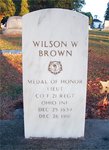 Harrison, MI
Harrison, MIOvercast, 36°
Wind: 18.4 mph, W
 Harrison, MI
Harrison, MI


Civil War Medal of Honor Winner Lived in Farwell
When I ran across this postcard of “The General” and it mentioned W.W. Brown from Farwell my interest was piqued. I had not heard his name, or this story connected to Farwell and Clare County when I researched Farwell (Arcadia Publishing, 2016.)
I still cannot find a census or other proof beyond newspaper clippings that Wilson Wright Brown lived in Farwell. In researching Brown, I’ve found his rank to that of a private, a lieutenant, a sergeant, and a captain!
Brown was born in Ohio on Dec. 25, 1839 and died in there on Dec. 26, 1916. He was one of the 19 men who received the Medal of Honor for his participation in the Andrews’ Raid during the Civil War. His citation read, “One of the 19 of 22 men (including 2 civilians) who, by direction of Gen. Mitchell (or Buell) penetrated nearly 200 miles south into enemy territory and captured a railroad train at Big Shanty, Ga., in an attempt to destroy the bridges and tracks between Chattanooga and Atlanta.”
Brown’s obituary leaves no clues about his residence in Farwell. He died at his home listed as 874 Forsyth, Toledo, Ohio. He is survived by fours sons and three daughter all of Ohio.
Clare Sentinel, April 26, 1907
Captain W.W. Brown will give a lecture Saturday, April 27th at 7:30 p.m. in the G.A.R. hall relating to Andrew’s raid of which was engineer.
Clare Sentinel, January 24, 1908
WAR HERO OF FAMOUS CIVIL WAR EXPLOIT
Capt. Brown of Farwell Remembered as Engineer of the “Great Railroad Chase.” A bill introduced in the United States senate to raise the pension of Capt. W. W. Brown, of Farwell from $30 to $50 per month recalls a thrilling story of the great rebellion. In the spring of 1862 Capt. J. J. Andrew with twenty-three men started on an expedition to cut railroad and telegraph communications between Chattanooga and Atlanta. Mr. Brown, then a private from Ohio, was one of the band. Disguised in citizens’ dress they slipped out of the union lines and trailed away in the direction of Chattanooga. Meeting at the agreed place, twenty-two in all, they carried only their side arms. They went from Chattanooga to Marietta arriving at midnight. Between them and the union lines was Chattanooga. On the morning of April 12th, 1862, they took passage on the ears back. At Big Shanty, where both crew and passengers took breakfast, the little force of men hurriedly to ok charge of the train. The engine and three box cars were uncoupled and with Brown at the throttle and the others acting as brakemen and firemen, the runaway train thundered away at full speed toward Chattanooga. Wood was their fuel, and they piled the furnace high dashing along at fifty miles an hour. The crew of the captured train got another locomotive and started in pursuit. The runaway train crew piled up obstructions, fired a bride and, setting on fire two of their box cars, left them standing on the track. But after 100 miles run the fuel and water gave out. The confederate locomotive very nearly overhauled them, and they escaped to the woods. Finally trailed down by bloodhounds they were lodged in the foul negro prison at Chattanooga. Capt. Brown with six others escaped. After six. weeks’ of wandering he reached Somerset, Ky., and thus made his way to the union lines. A few months subsequent to., his return Capt. Brown was severely wounded at the field of Chickamauga. His disabilities leave him now at the age of seventy-one years dependent on his country.
The exploit of the railroad chase is commemorated by a national monument in Chattanooga national cemetery.
Comments
No comments on this item Please log in to comment by clicking here